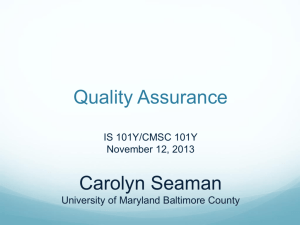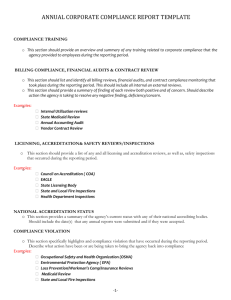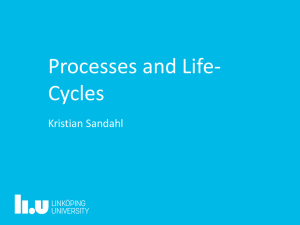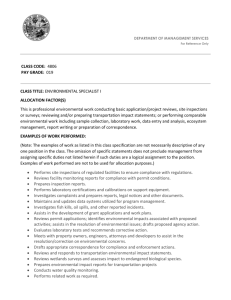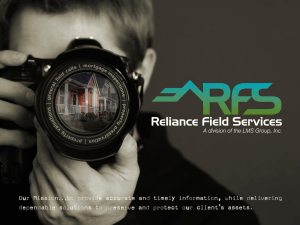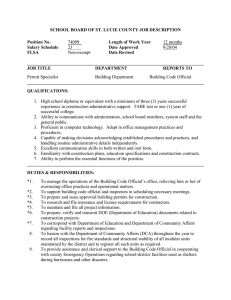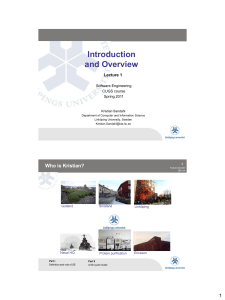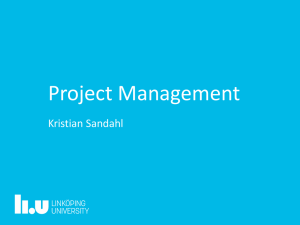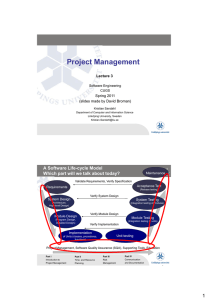Software Engineering Reviews autumn 2013
advertisement
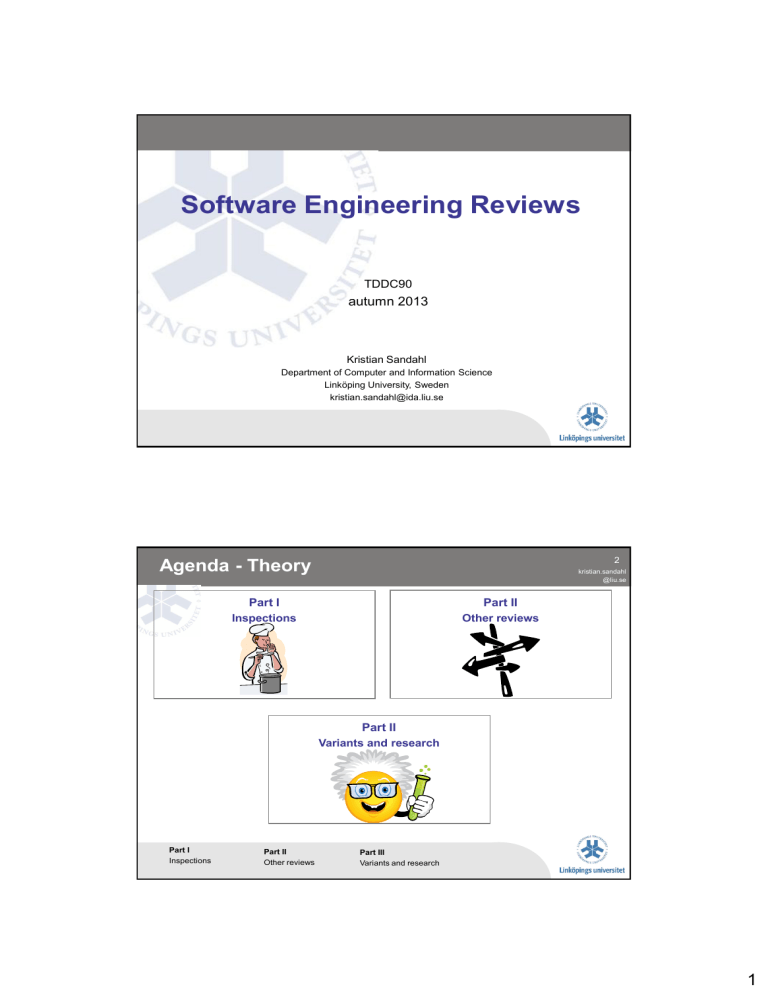
Software Engineering Reviews TDDC90 autumn 2013 Kristian Sandahl Department of Computer and Information Science Linköping University, Sweden kristian.sandahl@ida.liu.se 2 Agenda - Theory kristian.sandahl @liu.se Part I Part II Inspections Other reviews Part II Variants and research Part I Inspections Part II Other reviews Part III Variants and research 1 3 kristian.sandahl @liu.se Part I Inspections Part I Inspections Part II Other reviews Part III Variants and research 4 Systematic inspections kristian.sandahl @liu.se The best way of finding many defects in code and other documents Experimentally grounded in replicated studies Goals: Find defects (anomalies) Training Communications Hostage taking Part I Inspections Part II Other reviews Part III Variants and research 2 Development over the years Fagan publishes results from code and design inspections 1976 in IBM systems journal Basili and Selby show the advantage of inspections compared to testing in a tech-report 1985. Graham and Gilb publish the book Software inspections 1993. This describes the standard process of today. Presentation of the Porter-Votta experiment in Sorrento 1994 starts a boom for replications. Sauer et al compare experimental data with behavioural research in a tech-report 1996 IEEE std 1028 updated 2008 Part I Inspections Part II Other reviews Part III Variants and research 6 Roles 5 kristian.sandahl @liu.se kristian.sandahl @liu.se Author Moderator (aka Inspection leader) Reader (if not handled by the Moderator) Inspector Scribe (aka Recorder) Part I Inspections Part II Other reviews Part III Variants and research 3 7 Process kristian.sandahl @liu.se Group: Initial: Check criteria Plan Overview Individual: Preparation, or Detection Part I Inspections Part II Other reviews Detection, or Collection Inspection record Data collection Exit: Change Follow-up Document & data handling Part III Variants and research 8 Inspection record kristian.sandahl @liu.se Identification Location Description Decision for entire document: Pass with changes Reinspect Part I Inspections Part II Other reviews Part III Variants and research 4 9 Data collection kristian.sandahl @liu.se Number of defects Classes of defects Severity Number of inspectors Number of hours individually and in meeting Defects per inspector Defect detection ratio: Time Total defects Part I Inspections Part II Other reviews Part III Variants and research 10 Our inspection record Id Loc. Description kristian.sandahl @liu.se Class. 1 2 3 4 5 6 7 8 Part I Inspections Part II Other reviews Part III Variants and research 5 Practical investigation 11 kristian.sandahl @liu.se 214 code inspections from 4 projects at Ericcson Median number of defects = 8 90 percentile = 30 Majority values: up to 3.5 h preparation per document up to 3 h inspection time up to 4000 lines of code 2 to 6 people involved Inspection rate (IEEE Std 1028-2008) Requirements or Architecture (2-3 pages per hour) Source code (100-200 lines per hour) Part I Inspections Part II Other reviews Part III Variants and research Regression wrt defect detection ratio 12 kristian.sandahl @liu.se Preparation time per code line typically 0.005 hours per line (12 minutes per page) Size of document have negative effect on DFR, max recommendation 5000 lines A certain project is better than two of the others 4 inspectors seems best (not significant) Analysis performed by Henrik Berg, LiTH-MAT-Ex-1999-08 Part I Inspections Part II Other reviews Part III Variants and research 6 13 kristian.sandahl @liu.se Part II Other reviews Part I Inspections Part II Other reviews Part III Variants and research 14 Other reviews kristian.sandahl @liu.se Management review – check progress Technical review – evaluate conformance Walk-through – improve product, training Audit – 3rd party, independent evaluation (Peer) Review Buddy-check Desk check Part I Inspections Part II Other reviews Part III Variants and research 7 15 Root-cause analysis kristian.sandahl @liu.se Performed regularly for severe defects, frequent defects, or random defects Popular mind map: The Ishikawa diagram Parameters: Part I Inspections Defect category Visible consequences Did-detect Introduced Should-detect Reason Part II Other reviews Main cause Main Main cause cause Problem Main cause Main cause Main cause Part III Variants and research 16 kristian.sandahl @liu.se Part II Variants and research Part I Inspections Part II Other reviews Part III Variants and research 8 17 Reading techniques - checklist kristian.sandahl @liu.se defect attention area Checklist Industry standard Shall be updated Part I Inspections Part II Other reviews Part III Variants and research Reading techniques - scenario 18 kristian.sandahl @liu.se Scenario A checklist splitted to different responsibilities 30% higher DFR ? Part I Inspections Part II Other reviews Part III Variants and research 9 Reading techniques – perspective-based 19 kristian.sandahl @liu.se Different inspectors represent different roles Real or played roles 30% higher DFR ? Part I Inspections Part II Other reviews Part III Variants and research 20 Cost of quality kristian.sandahl @liu.se Person-hours Calender time Good reading techniques Good data recording Part I Inspections Part II Other reviews Part III Variants and research 10 ”Optimal” method 21 kristian.sandahl @liu.se Inspectors Repository Two experts Defect list False positives Part I Inspections Part II Other reviews Part III Variants and research Summary - What have we learned today? 22 kristian.sandahl @liu.se Inspections rule! Inspections are expensive Part I Inspections Part II Other reviews Part III Variants and research 11
